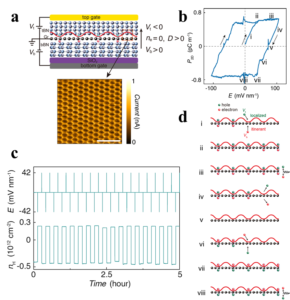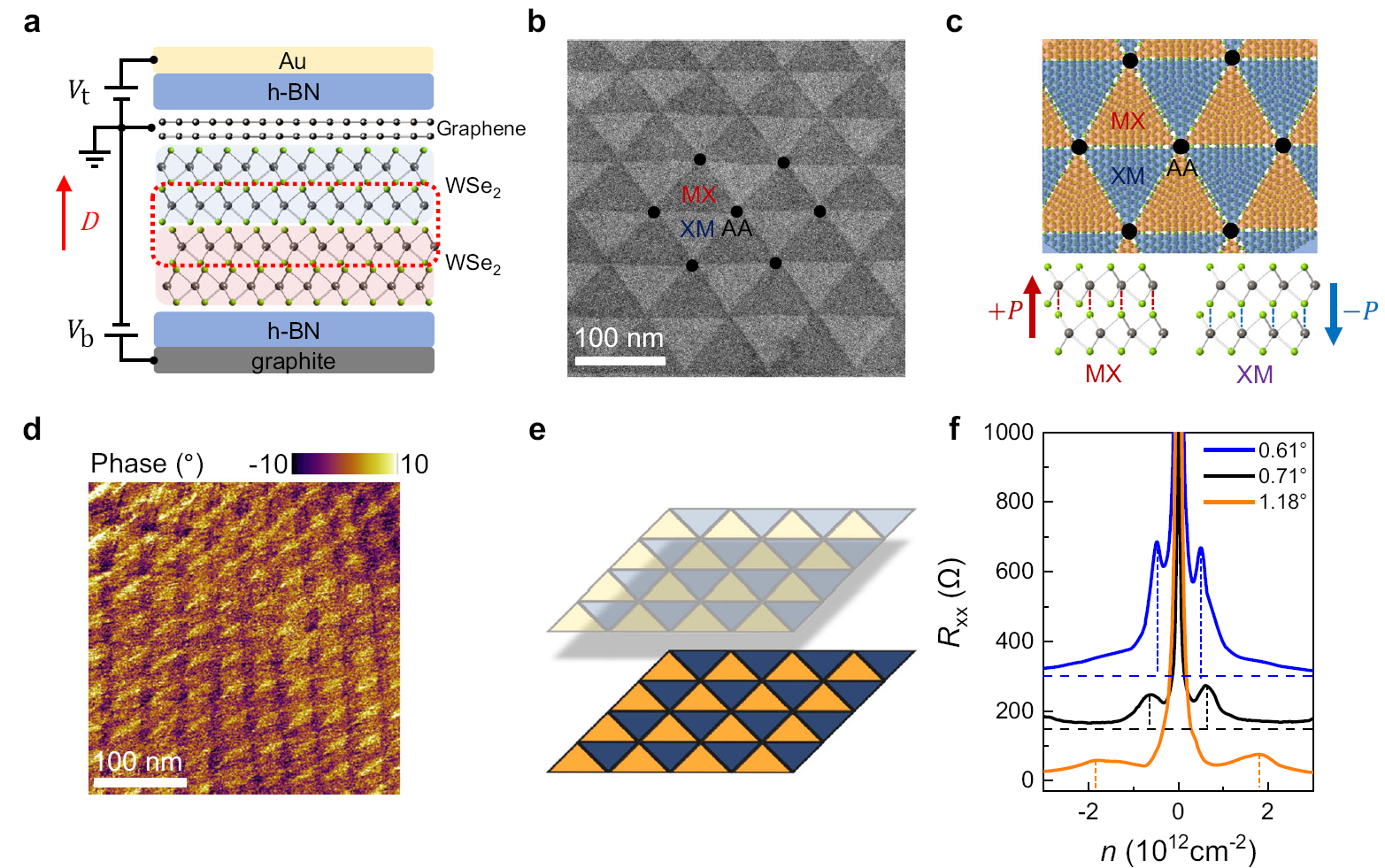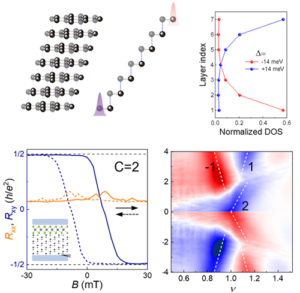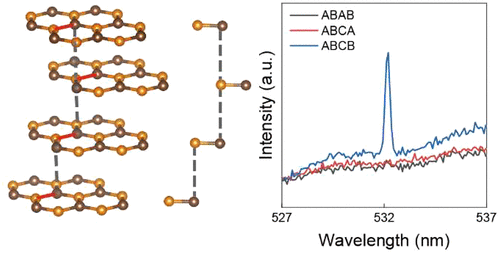1. Electronic ferroelectricity in monolayer graphene moiré superlattices
Monolayer graphene as an elementary two-dimensional material unlikely exhibits ferroelectric order due to its highly centrosymmetric hexagonal lattices. Surprisingly, we observe electronic ferroelectricity in monolayer graphene by introducing asymmetric moiré superlattice at the graphene/h-BN interface, in which the electric polarization stems from electron-hole dipoles. The polarization switching manifests as standard polarization-electric field hysteresis loops. Furthermore, we demonstrate the applications of this ferroelectric moiré structures in multi-state non-volatile data storage with high retention and the emulation of versatile synaptic behaviors. Our work not only provides insights into the fundamental understanding of ferroelectricity, but also demonstrates the potential of graphene for high-speed and multi-state non-volatile memory applications.

Ref:
Le Zhang, Jing Ding, Hanxiao Xiang, Naitian Liu, Wenqiang Zhou, Linfeng Wu, Na Xin*, Kenji Watanabe, Takashi Taniguchi*, Shuigang Xu*,“Electronic ferroelectricity in monolayer graphene moiré superlattices”,Nature Communications, 15, 10905, (2024).
2. Moiré ferroelectricity
The stacking order and twist angle provide abundant opportunities for engineering band structures of two-dimensional materials, including the formation of moiré bands, flat bands, and topologically nontrivial bands. The inversion symmetry breaking in rhombohedral-stacked TMDCs endows them with an interfacial ferroelectricity associated with an out-of-plane electric polarization. By utilizing twist angle as a knob to construct rhombohedral-stacked TMDCs, antiferroelectric domain networks with alternating out-of-plane polarization can be generated. We demonstrate that such spatially periodic ferroelectric polarizations in parallel-stacked twisted WSe2 can imprint their moiré potential onto a remote bilayer graphene. Our results offer a comprehensive strategy for engineering band structures and properties of two-dimensional materials by utilizing moiré ferroelectricity.

Ref:
Jing Ding, Hanxiao Xiang, Wenqiang Zhou, Naitian Liu, Qianmei Chen, Xinjie Fang, Kangyu Wang, Linfeng Wu, Kenji Watanabe, Takashi Taniguchi, Na Xin, Shuigang Xu*, “Engineering band structures of two-dimensional materials with remote moiré ferroelectricity”, Nature Communications, 15, 9087, (2024).
3. Exotic quantum states in rhombohedral multilayer graphene
Flat-band systems with strongly correlated electrons can exhibit a variety of phenomena, such as correlated states, superconductivity and topological states. Rhombohedral multilayer graphene has recently emerged as a promising platform for investigating exotic quantum states due to its hosting of topologically protected surface flat bands at low energy. In this topic, we succeed in isolating the surface flat bands of rhombohedral multilayer graphene by introducing moiré superlattices through zone folding effects. With this strategy, we observe tunable layer-polarized ferromagnetism, which is evidenced by a hysteretic anomalous Hall effect. Moreover, in rhombohedral decalayer graphene, we observed quantum anomalous Hall insulators with high-Chern number.

Ref:
Wenqiang Zhou†, Jing Ding†, Jiannan Hua†, Le Zhang, Kenji Watanabe, Takashi Taniguchi, Wei Zhu*, Shuigang Xu*, “Layer-polarized ferromagnetism in rhombohedral multilayer graphene”, Nature Communications, 15, 2597, (2024).
Jing Ding†, Hanxiao Xiang†, Jiannan Hua†, Wenqiang Zhou, Naitian Liu, Le Zhang, Na Xin, Bing Wu, Kenji Watanabe, Takashi Taniguchi, Zdeněk Sofer, Wei Zhu, and Shuigang Xu*, “Electric-field switchable chirality in rhombohedral graphene Chern insulators stabilized by tungsten diselenide”, Phys. Rev. X, in press, (2025).
4. Symmetry breaking in tetralayer graphene
Stacking orders provide a unique way to tune the properties of two-dimensional materials. Here, we observe pronounced nonlinear optical second-harmonic generation in ABCB-stacked tetralayer graphene while absent in both ABAB- and ABCA-stacked allotropes. Our results provide direct evidence of symmetry breaking in ABCB-stacked tetralayer graphene and establish ABCB-stacked graphene as a unique platform for studying the rare ferroelectricity in non-centrosymmetric elemental structures.

Ref:
Wenqiang Zhou†, Jiannan Hua†, Naitian Liu, Jing Ding, Hanxiao Xiang, Wei Zhu, Shuigang Xu*, “Inversion Symmetry-Broken Tetralayer Graphene Probed by Second-Harmonic Generation”, Nano Letters, 24, 8378-8385, (2024).